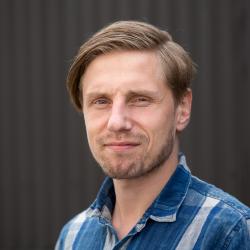Published May 12, 2017
I always imagined that my first time snorkelling would take place in warm water off the coast of some Caribbean paradise—probably listening to Sean Paul, preferably with Sean Paul. Surely not in 2°C water in Iceland with a company called Arctic Adventures, in weather that can best be described as ‘Icelandic’. I would look for turtles and fear losing a leg to a shark attack, but how fortunate that instead I got to do it in Silfra in Þingvellir.

Guide for the day: Þorgils Gunnarsson, or ‘Gilli guide’ as he likes to be called. A burly veteran of 14 years with a mountain sized personality. If you like your geological lessons served with human anatomy metaphors and dad jokes then he’s your man.
Silfra is one of Iceland’s most remarkable spots. The water in the river is so transpicuous that you almost forget that it’s there. I will probably never go into space (unless the world continues its descend into madness and we all need to leave Earth) and, therefore, will not get to fly around in zero gravity, so letting Silfra’s gentle stream float me on is without a doubt the closest I will get.
With depths of up to 18 metres and perfect visibility, my fear of heights kicked in as I entered the water. The river is a haunting blue and alien like green algae covers the underwater banks, with occasional strips breaking off and dancing away in front of your eyes.




I am much to anxious to meditate—I’d fear that clearing my mind would cause me to lose it—but snorkelling in Silfra is like a brutalist form of meditation. If Goethe had written a book on mindefulness it would be something a kin to the experience. Harsh, bare rocks and boulders cover the bottom and the only noise is the sound of your breathing.
The water is so cold that if it wasn’t for my double layered suit, it would take just minutes to turn my unreal experience into a Leonardo DiCaprioesque catastrophe. But what also makes Silfra unique is that it is the divergent tectonic boundary between North America and Europe. Every year it expands by 2 cm, as the Old and the New World drift a part—only Trump causes a bigger divide between the two continents.



Descent into complete darkness.
The second part of the tour of Þingvellir took me underground into the Gjábakkahellir cave, which was formed by a volcanic eruption that took place around the time humans domesticated the cow. The 9000 years old lava tube is filled with brutalist rock and ice formations, and the walls are dotted with strangely coloured formations that could easily be mistaken for shiny silver, but are in fact ancient bacteria that live off water that drips through small cracks in the lava rock.
The high point of the subterranean trip (or low point in this case) was experiencing total and utter darkness. We sat down, turned off our lanterns and all light left our world. As you would say in Icelandic: “ég sá ekki rassgat” (lit: I didn’t see an asshole). This was only the third time in my life that I have wanted to be a bat.
The tour was one of the better ones I’ve done in Iceland and I’ve recommended it to anyone who has been willing to listen (which in my case are not that many).
Þingvellir is one of only two Unesco World Heritage Sites in Iceland—the other being the island of Surtsey—and it was here where a group of Norwegians fleeing religious persecutions founded the world’s oldest uninterrupted parliament in 930. And as it is only a 45 minute drive away from Reykjavík, you really don’t have any excuse.


















